Rehab Technologies
Types of rehab technologies
The team of experienced therapists at Main Line Health work with you based on your individual needs and offer therapy that best fits your rehabilitation goals. Through the use of exoskeleton robotic devices for the upper and lower extremities, you’ll be getting care from experts with the latest technology in rehabilitation.
No matter the level of assistance collaboration you need, you’ll have access technologies that can help your medical team track, record and make choices for your care using feedback from these devices — offering you more accurate care as a result.
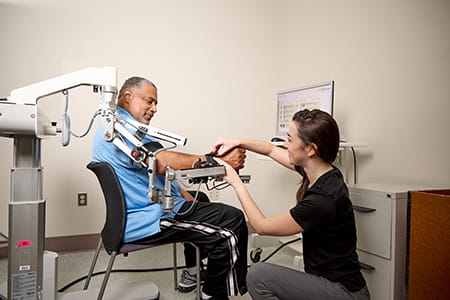
Armeo®Spring system
The Armeo®Spring system is a robotic device that helps when you have minimal function in your arms due to cerebral, neurologic, spinal, muscular and bone-related disorders. The adjustable device supports you at the forearm and upper arm with a robotic exoskeleton that counterbalances the weight of the arm. This makes it easier to overcome gravity while performing upper-limb movements. The exoskeleton mimics the complex movements of the upper arm by stabilizing and moving with your arm movements.
The therapists at Bryn Mawr Rehab Hospital use the ArmeoSpring for neurologic conditions — such as stroke, brain injury, spinal cord injury and Parkinson's disease — to help you regain the ability to perform tasks without help. The device records your progress based on each treatment session, so your therapist can track improvement in arm movement. ArmeoSpring treatment is available for both inpatient and outpatient occupational therapy sessions, helping achieve motor control. As a result, you’re able to better able to complete functional tasks like getting dressed or reaching for items on a shelf.
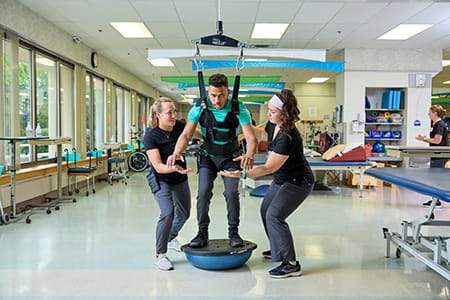
Bioness Vector Gait and Safety System
Bioness Vector Gait and Safety System is a body weight support harness system used during gait training and other forms of rehabilitation. The ceiling-mounted system is designed to support mobility and balance training while virtually eliminating the risk of falls and injuries.
The Bioness Vector has intuitive and dynamic body weight support that adapts to your movements during individualized mobility tasks. The support rope automatically shortens and extends as your center of gravity moves up or down, allowing you to perform different activities, such as step ups, squats, lunges and kneeling — all while maintaining a consistent percentage of body weight support.
The therapists at Bryn Mawr Rehab Hospital use the Bioness Vector Gait and Safety System for exercises to help neurologic conditions — such as stroke, brain injury, spinal cord injury, Parkinson's disease — as well as orthopaedic injuries.
The system is used in both inpatient and outpatient settings to support the patient and assists in preventing falls during dynamic rehabilitative activities, allowing the therapist to view more of the mobility activity as a whole and focus more on quality of movement to assist in your recovery process.
The Bioness Vector is also used when you don’t need as much hands-on assistance while performing higher level balance activities, such as jumping, jogging or even rollerblading. The Bioness Vector can help accelerate recovery and improve outcomes and satisfaction — so you can return to individualized activities earlier in your recovery process.
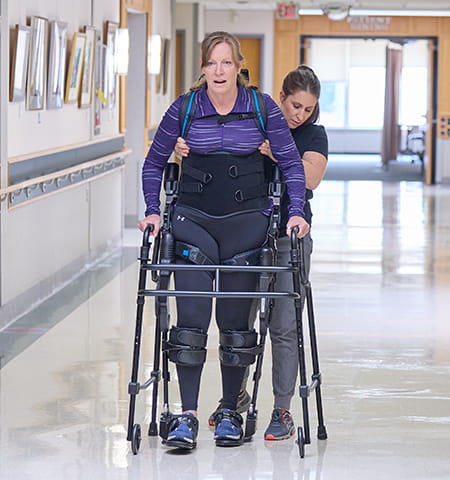
Exoskeleton robotic device
The therapists at Bryn Mawr Rehab use this device for gait training and pre-gait activities — exercises to help people who have experienced a brain injury, stroke or an incomplete spinal cord injury. The exoskeleton robotic device is a wearable, battery-operated bionic exoskeleton that is used to allow patients with lower extremity weakness or partial paralysis to stand and walk on level surfaces. Motors power the hip and knee joints, and the patient initiates all motion either through specific actions or by using an external controller.
Undergoing this training can result in improved balance without assistance and, for some people, their walking distance and gait speed also improves. Your therapist will assess your personal goals and conditions to offer treatment and decide if the exoskeleton robotic device could work for you.
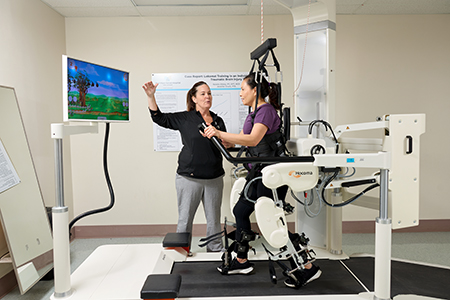
Lokomat®
The Lokomat® is a robotic device that helps you learn how to walk again after experiencing an injury or if you have a condition that impairs your walking ability. The device uses a customized suspension system and exoskeleton to provide support over a treadmill, as well as limb guidance. The therapists at Bryn Mawr Rehab Hospital attach the exoskeleton robotic legs to your legs, and can then control how fast you walk, how much body weight can be supported and how much help the robotic legs give you during treatment.
Therapists uses the Lokomat in both inpatient and outpatient settings to help those with spinal cord injuries, brain injuries, stroke, multiple sclerosis, Guillain-Barré syndrome and other neurologic conditions improve their strength, motor planning, coordination and sequencing during walking.
The therapists at Bryn Mawr Rehab Hospital use this technology early in the rehabilitation process — when recovery is quickest — and throughout your treatment to retrain and fine-tune movements. Through repetition and taking multiple "correct" steps, Lokomat therapy can help you re-learn "normal" walking mechanics. This learning carries over to improvements in overground walking. This technology has helped many people achieve great success in improving the quality, speed and accuracy of walking, as well as overall endurance.
Lokomat can be used as a complement to traditional physical therapy interventions throughout the course of inpatient or outpatient care. To determine if Lokomat is the appropriate therapy for you, your trained physical therapist will provide you with an assessment to determine if it could be helpful in your therapeutic care.
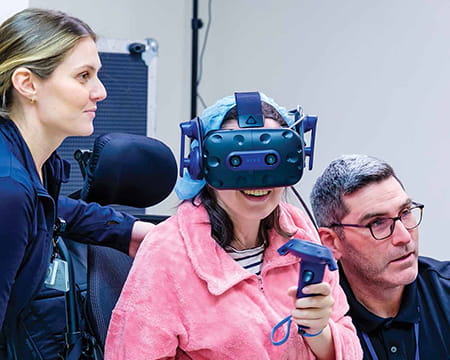
Virtualis VR Goggles
Virtualis Virtual Reality Rehabilitation Goggles are a cutting-edge tool to enhance treatment for conditions from traumatic brain injury and stroke to MS and chronic pain.
Virtualis VR transports patients to a virtual environment, free from the distractions of the hospital. Patients hold or stand on the device’s controllers while they engage in tasks and challenges that would otherwise require significant time and props to create in the real world. The technology enables therapists to fully customize the patient’s session, quantify their ability to engage in specific complex movements, and motivate patients in a fun and engaging new way.